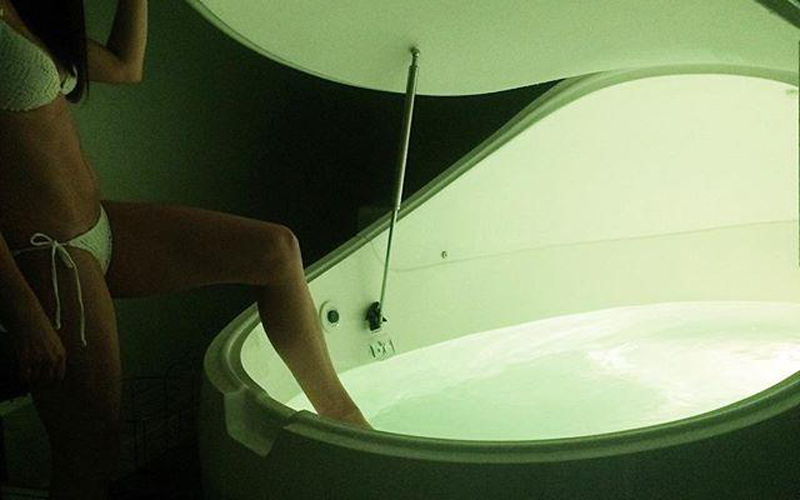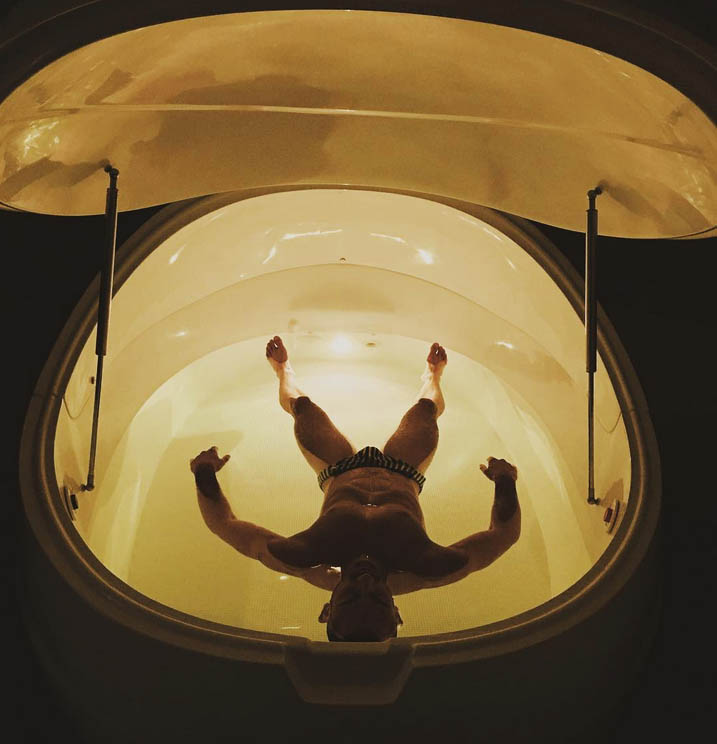
Sensory deprivation tanks, also known as isolation tanks or floatation tanks, have seen a tremendous rise in popularity in recent years. While once on the fringe between alternate medicine and recreational drug culture, a number of recent scientific studies have helped to push floatation into the mainstream.
Floatation has a number of reported benefits, from athletes reporting improved injury recovery times and benefits post exercise, to everyday people who report a profound sense of lasting mental peace and relaxation.
In the mental health area, floatation has a number of studied and reported benefits such as improved mindfulness, stress reduction and noted decreases in depression and anxiety symptoms, along with physical benefits such as promoting a decrease in blood lactate levels and lowering of available cortisol following eccentric exercise. Floatation is also known to assist in providing relief for both chronic pain and post trauma pain levels.
The idea that floatation tanks are more the product of pseudo-science or ‘hippy’ beliefs has now been mostly debunked. Floatation has since moved into the realms of a legitimate alternative therapy for a number of health treatments.
The history of the isolation tank

The beginnings of the isolation tank began during the 1950’s, when eccentric neuroscientist Dr John C. Lilly first began experiments at the National Institute of Mental Health, where he explored the results of isolating the human brain from all external stimulation. Prior to his experiments, it was debated that in the instance of total sensory deprivation, whether the result would be the brain simply shutting down entirely or it’s continuation and function as a totally independent organ. For these experiments, Dr Lilly used a small above ground swimming pool and a total face hood with external air supply.
Test subjects would enter the pool and by curling their elbows to their knees while laying face down in the tank, which would induce floatation where by their back was the only part of the body floating and exposed. While this study did prove the brain is able to function entirely independently, without requiring sensory input, trial subjects reported the experience as promoting a strong fear of drowning, and by no means pleasant.
It was not until the 1970’s, when Glenn Perry, while being mentored by Dr Lilly, created the first modern floatation tank, along with founding the first commercial company selling floatation tanks, the Samadhi Tank Co.
Due to Mr Perry’s small size, he found it difficult to induce floatation while attempting to float in the traditional method. To counter this, Dr Lilly recommended the addition of salt to the tank’s water, which would increase buoyancy of the human body. After some experimentation, it was decided the best method would be total saturation of the water using salt, to create instant buoyancy, and to eliminate any irritation to the skin, the use of sea salt was replaced with Epsom-salt, at a 50% Epsom-salt to water ratio.
During this time, the idea that total sensory deprivation should come from a sound and light proof ‘isolation tank’ was also decided upon, hence the modern floatation tank was born.
The movement of modern sensory deprivation tanks from creation into acceptance.
Following the move of sensory deprivation into a commercial product, Dr Lilly himself became an avid user and advocate of the tank. Dr Lilly’s following however, was fairly alternative. Some of his other research was into areas such as inter-species communication, particularly Human-Dolphin relationships, he was also involved in the 1960’s Search for Extra-terrestrial Intelligence project, before finding a personal love and lifelong interest in psychedelic drugs such as LSD and Ketamine. He often reported combining these drugs with sessions inside his isolation tank, which most people looking back upon would definitely understand this was a rather dangerous combation.
Later in his life he became a believer that modern electronics would eventually leading to a dramatic conflict between humans and what he termed the ‘Solid State Intelligence’, a matrix style theory whereby our technology development will eventually give birth to a new and more powerful artificial intelligence.
From this, it is easy to see why floatation had, and to a point still has, a large following from people out of the mainstream. The therapy mainly invoked interest within groups also interested in psychedelic drug use and the hippy culture. Over time however, the benefits of floatation, mainly in mindfulness and due to the euphoria most people report following a session, led to an acceptance within a wider audience.
However this was still fairly limited, until some higher profile journalists and celebrities, the most notable being Joe Rogan, began to speak about isolation tank use, first in the context of psychedelic drug use, and later revoking this to recommend only the tank itself. From this, the fringe followers of Joe Rogan pushed the idea of isolation tanks and sensory deprivation further into mainstream knowledge, until it began to provoke the interest of modern scientific experiments, most of which have been conducted over the last decade, helping floatation to move into mainstream acceptance and popularity.
The method of modern floatation which makes the experience possible

The method which makes the sensory deprivation experience possible is a fairly simple process. The basis of a sensory deprivation tanks preparation always includes four main areas. Without these, the experience is either diminished or not possible.
Water Solution: The water solution which enables the entire floatation process, consists of 1000 litres of water, with 50% Epsom-salt (500kg) added to 50% (500L) of water. This level of solution provides instant floatation when lying flat on one’s back or stomach. To maintain the solution, constant filtration is required. This is often carried out between sessions and left on constant filtration overnight. PH levels are constantly monitored and water or Epsom-salt added to correct levels as required. The water is constantly UV filtered to destroy any micro-organisms inside the water, keeping it sterile. Constant monitoring for the detection of any contaminants, such as trace amounts of ammonia, also occurs, which would signal a requirement to change the solution.
Water Temperature: Temperature is another important part of the sensory deprivation experience. The human body skin temperature is a constant 34 degrees Celsius, while the inner temperature of the human body is 37 degrees Celsius. A water temperature of 35.5 degrees is often maintained inside a floatation tank, however can range up to a maximum of 37 degrees Celsius. The reason for this temperature is to remove the ability for the skin and body to detect the water solution being present, hence after a few minutes inside a floatation tank, the body essentially begins to ‘forget’ the liquid is present, promoting a feeling of floating in space or existing in a state of nothingness.
Total Sound Proofing: Floatation tanks are designed to totally eliminate external noise. This is done through insulation of the fibreglass used in construction, along with the sealing of the entrance/exit point of the tank. Some tanks utilise a conventional door with rubber seals, while others will have the point at which the float ‘pod’ closes, shaped in a manner which seals it completely.
Total Light Elimination: The total elimination of light is a key point in the experience of sensory deprivation. Light is the key sensory input the brain uses to switch between stimulation and rest. For this reason, floatation tanks are designed to block out any external light from entering, through both construction and pod sealing. While the first floatation tanks were entirely dark inside, most tanks on the market today feature an internal light which can be turned on or off via a button on the inside. This makes finding a comfortable position easier, along with allowing the ability to obtain a better central placement within the tank while floating, before beginning the full experience.
What to expect when taking part in a floatation tank session

Floatation therapy centres are popping up in most cities, both major and regional. Today it is not difficult to find a floatation tank provider throughout most parts of Australia. Being located in Melbourne, I decided upon booking a few one hour sessions with Rest House Float Centre in Hampton East. I will run you through the experience of the floatation therapy sessions I experienced.
Upon first visit you are required to fill out a form, basically giving your contact details and details of your health. This took a few minutes to complete.
Then an introduction to the tanks takes place. You are instructed on how to float and how to prepare for your float. Before floating it is required to fit ear plugs, along with applying a petroleum jelly like solution to any cuts, sores or grazes to prevent stinging when entering the tank. As Epsom salt is good for the skin, if you can put up with 10 minutes of stinging at first then the petroleum jelly can be excluded. Fitting the ear plugs before the shower is important, as once your ears are wet it will be difficult for the earplugs to stay in place.
Floatation is recommended without wearing any clothing. The rooms are locked, and there is an inner hallway which people are walked through to their individual rooms before they begin each session, leaving no possibility of someone walking in on you. This inner hallway is also helpful, as it provides one extra layer of separation between the reception area and the floatation tank rooms, lowering the chance of external noise if you decide to float with the floatation pods entrance open a little. Each room has a light switch, to remove any outside light within the room.
Following your introduction, you are left alone to take part in your session. During your shower the music in the tank begins playing. This indicates the beginning of the session. Once you have showered you make your way into the tank, and close the entrance. Now inside the tank, you find a comfortable and stable floating position, and then press the button on the side to turn the light off.
Upon taking the first ever session, it can take a little time to become accustomed to the floatation experience. You will notice that when you float, if you push yourself off the side of the tank even a tiny bit, your body will go flying to the other side of the tank fairly quickly. It is very similar to what happens in a zero gravity environment. The best method is if your body floats and touches the edge of the tank, just allow it to occur, because once it does you will again begin floating towards the centre of the tank, and provided you do not push yourself off the edge, normally after a few minutes your body will settle into the middle of the tank.

Now inside the tank, you quickly become aware of all the thoughts going through your head. The absence of all noise, light and presence of your body means you are able to focus more upon what is going through your mind. If you do not have a lot of stress going on, you may find you are not thinking anything when you enter the tank, however if you are very stressed, the thought patterns become obvious, and once you become aware of them, can choose to ignore or even stop thinking about them. If you have trouble calming your mind down to a complete stop, don’t stress over this, just enjoy your time in the tank and observe your thoughts as though you are a third person listening to them. Often by doing this you will be able to stop thinking after some time without any need to force this to occur.
If you find yourself inside the tank, with absolutely no thoughts going through your mind, this is the perfect state to be in. Just enjoy the total nothingness the experience provides. This will induce a deep physical and mental relaxation, along with promoting an extreme state of positive mindfulness. The ability to feel, see, think and do nothing is the key to this experience, and produces the best results afterwards. Personally it took me a little while in my first session to experience this, as my mind was constantly chattering away, but I did get around 15 minutes worth at the end, and it becomes easier with further sessions.
At the end of your session, the music in the tank begins to play again. This is soft music full of nature sounds, which eases you back into reality and allows you to regain yourself in preparation to leave the tank. Once you are ready, you can press the button to turn the light on, and then open the hatch at the top to exit the float pod.
At this point you take another shower, making sure to clean your entire body to remove the Epsom salts present on your skin and throughout your hair. Remove the ear plugs and rinse your ears to remove the salt build up around where the ear plugs were positioned, making sure not to get water inside your ear canals.
Following your shower you can get dressed. There is a powder room if you need it, which has mirrors and hair dryers. Then you proceed back to the lounge and relax on the couch. At this point, the profound relaxation you have obtained becomes apparent. Everything is super slowed down to the present moment. The mind is at perfect ease with itself, and you feel absolutely amazing. The staff prepare a herbal tea and you can spend as much time as you like in the lounge, until you are ready to head back out into the ‘normal world’.
I found this profound relaxation and ability to simply be in the present moment lasted for four weeks, at which point it began to diminish. However after taking another session at the four-week point, the relaxation returned again, and was prolonged by one more further session three weeks later. So floating every three weeks to once per month appears to have the most benefits.
Most floatation providers will have membership packages so you can float regularly. This reduces the overall cost of the sessions and most times if you can’t make it in during one month, you can roll the floatation sessions into the next month.
Floatation in Retrospect/Summary

Having heard a lot about these tanks over the years, now finally trying out a few sessions, it has become apparent to me that sensory deprivation definitely has benefits, especially if you have a lot of stress. Having tried out hypnosis and meditation previously and not achieved any meaningful results (mainly due to a high level of work related stress present at the time, preventing benefits), I was surprised at how easily it was for me to enter into a deep meditative state when using a floatation tank.
The euphoria and sense of being in the present moment following a session is a great feeling, and I feel this is probably what keeps most regular floaters coming back. It feels similar to being on a high dose of sedatives without needing to take anything, and the relief from anxiety and stress following the session for a few weeks afterwards was great too.
Having spoken to other people who have taken part in floatation, a number reported similar after-feelings such as I experienced, but seemed to have lower stress and anxiety levels generally before taking part, so didn’t notice a supremely intense shift in their daily lives the weeks following their sessions. Another who took part reported it difficult to find a comfortable position in the tank due to his collapsed spinal disc from a past injury, leading to conclude the experience had no benefits for him, while others involved in professional sports reported seeing a benefit in their learning, recovery and creativity. So in retrospect it seems the therapy has different effects upon different people. It is not simply a fixed experience or fixed set of benefits and negatives.
Either way, the experience is certainly different, and if at least, the experience of floatation itself is something really enjoyable and fun, especially during the first float. It gives a feeling as though one is floating in space – a feeling of anti-gravity, while also providing me a good idea of what the Dead Sea (located between the Israel/Palestine and Jordanian borders) must be like, as the amount of salt in the water there causes the same floatation experience.
Whether the therapy will be worthwhile, it seems, really depends upon the individual, but as a new experience and a bit of a personal experiment, it’s definitely something that I feel people should experience at least once. You will likely take something positive from it, even if it is at the very least the fun and novelty of the floatation experience itself.










2 Responses
[…] For in depth information on floatation benefits, the history of floatation, and what is involved in taking part in floatation tank therapy, please visit the following Floatation Therapy article at Adore Australia. […]
[…] Fore more information on enclosed floatation tanks, take a look at the Floatation Tanks article at the Adore Australia blog. […]